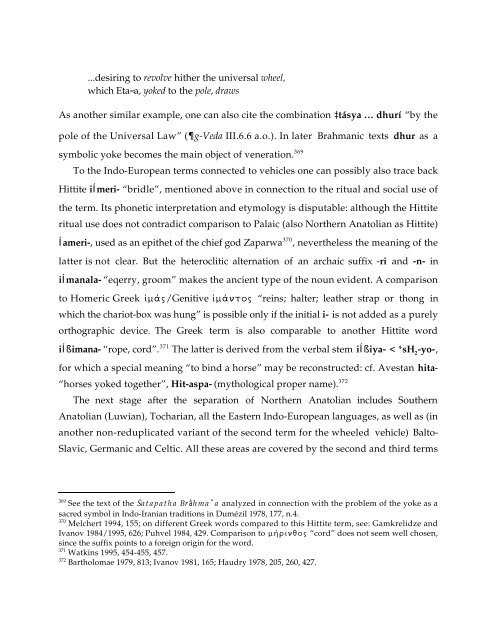Comparative Notes on Hurro-Urartian, Northern Caucasian
Comparative Notes on Hurro-Urartian, Northern Caucasian
Comparative Notes on Hurro-Urartian, Northern Caucasian
Create successful ePaper yourself
Turn your PDF publications into a flip-book with our unique Google optimized e-Paper software.
...desiring to revolve hither the universal wheel,<br />
which Eta≈a, yoked to the pole, draws<br />
As another similar example, <strong>on</strong>e can also cite the combinati<strong>on</strong> ‡tásya … dhurí “by the<br />
pole of the Universal Law” (g-Veda III.6.6 a.o.). In later Brahmanic texts dhur as a<br />
symbolic yoke becomes the main object of venerati<strong>on</strong>. 369<br />
To the Indo-European terms c<strong>on</strong>nected to vehicles <strong>on</strong>e can possibly also trace back<br />
Hittite iÍmeri- “bridle”, menti<strong>on</strong>ed above in c<strong>on</strong>necti<strong>on</strong> to the ritual and social use of<br />
the term. Its ph<strong>on</strong>etic interpretati<strong>on</strong> and etymology is disputable: although the Hittite<br />
ritual use does not c<strong>on</strong>tradict comparis<strong>on</strong> to Palaic (also <strong>Northern</strong> Anatolian as Hittite)<br />
Íameri-, used as an epithet of the chief god Zaparwa 370 , nevertheless the meaning of the<br />
latter is not clear. But the heteroclitic alternati<strong>on</strong> of an archaic suffix -ri and -n- in<br />
iÍmanala- “eqerry, groom” makes the ancient type of the noun evident. A comparis<strong>on</strong><br />
to Homeric Greek flmãw/Genitive flmãntow “reins; halter; leather strap or th<strong>on</strong>g in<br />
which the chariot-box was hung” is possible <strong>on</strong>ly if the initial i- is not added as a purely<br />
orthographic device. The Greek term is also comparable to another Hittite word<br />
iÍßimana- “rope, cord”. 371 The latter is derived from the verbal stem iÍßiya- < *sH 2 -yo-,<br />
for which a special meaning “to bind a horse” may be rec<strong>on</strong>structed: cf. Avestan hita-<br />
“horses yoked together”, Hit-aspa- (mythological proper name). 372<br />
The next stage after the separati<strong>on</strong> of <strong>Northern</strong> Anatolian includes Southern<br />
Anatolian (Luwian), Tocharian, all the Eastern Indo-European languages, as well as (in<br />
another n<strong>on</strong>-reduplicated variant of the sec<strong>on</strong>d term for the wheeled vehicle) Balto-<br />
Slavic, Germanic and Celtic. All these areas are covered by the sec<strong>on</strong>d and third terms<br />
369 See the text of the Íatapatha Brâhmaˆa analyzed in c<strong>on</strong>necti<strong>on</strong> with the problem of the yoke as a<br />
sacred symbol in Indo-Iranian traditi<strong>on</strong>s in Dumézil 1978, 177, n.4.<br />
370 Melchert 1994, 155; <strong>on</strong> different Greek words compared to this Hittite term, see: Gamkrelidze and<br />
Ivanov 1984/1995, 626; Puhvel 1984, 429. Comparis<strong>on</strong> to mÆrinyow “cord” does not seem well chosen,<br />
since the suffix points to a foreign origin for the word.<br />
371 Watkins 1995, 454-455, 457.<br />
372 Bartholomae 1979, 813; Ivanov 1981, 165; Haudry 1978, 205, 260, 427.





